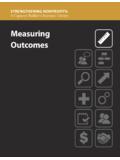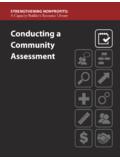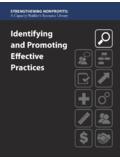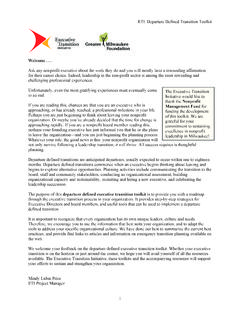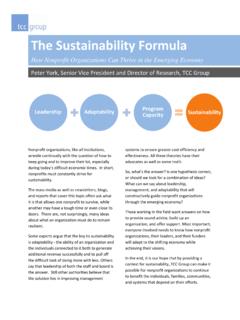Transcription of Building Multiple Revenue Sources - Strengthening …
1 Building Multiple Revenue SourcesSTRENGTHENING NONPROFITS: A capacity Builder s Resource LibraryTABLE OF CONTENTSINTRODUCTION ..4 OVERVIEW ..5 Revenue Sources ..5 Annual or sustained gifts ..6 Major gifts ..6 Planned gifts ..6 Foundation grants ..6 Cause-related marketing ..6 Corporate giving programs ..7 Earned income activities ..7 Unrelated business income ..7In-kind donations ..7 Supporting organizations ..7 Benefit events ..8 State and local municipalities ..8 Churches and denominations ..8 Federated funds ..8 Online donations ..8 MORE ABOUT ONLINE TOOLS TO ENHANCE FUNDRAISING ..8 Causes on Facebook ..9 Network for Good ..9 AlumniFidelity ..10 FirstGiving ..10 Managing Change when Adopting Web Fundraising Tools ..11 THE Revenue DEVELOPMENT PROCESS ..11 Step 1: Assess Goals for the Future and Current Resource capacity ..11 Step 2: Identify Your Income Strategy ..17 Step 3: Select an Appropriate Revenue Source ..20 Step 4: Develop and Execute a Revenue Source Plan.
2 26 Step 5: Evaluate Results and Strive for Improvement ..28 SUMMARY ..30 APPENDICES ..31 APPENDIX A: Resources ..31 APPENDIX B: Glossary ..34 APPENDIX C: Resources for Online Giving and Social Media Marketing ..36 APPENDIX D: Web Tool Report Card ..37 APPENDIX E: Goals and Financial Resources ..39 APPENDIX F: Revenue Source Plan Summary ..42 APPENDIX G: Systems Area Summary ..434 INTRODUCTIONThe Compassion Capital Fund (CCF), administered by the Department of Health and Human Services, provided capacity Building grants to expand and strengthen the role of nonprofit organizations in their ability to provide social services to low-income individuals. Between 2002 and 2009, CCF awarded 1,277 grants, and the CCF National Resource Center provided training and technical assistance to all CCF grantees. Strengthening Nonprofits: A capacity Builder s Resource Library is born out of the expansive set of resources created by the National Resource Center during that time period, to be shared and to continue the legacy of CCF s capacity Building work.
3 Strengthening Nonprofits: A capacity Builder s Resource Library contains guidebooks and e-learnings on the following topics:1. Conducting a Community Assessment2. Delivering Training and Technical Assistance3. Designing and Managing a Subaward Program4. Going Virtual5. Identifying and Promoting Effective Practices6. Leading a nonprofit Organization: Tips and Tools for Executive Directors and Team Leaders7. Managing Crisis: Risk Management and Crisis Response Planning8. Managing Public Grants9. Measuring Outcomes10. Partnerships: Frameworks for Working Together11. Sustainability12. Working with ConsultantsWho is the audience for Strengthening Nonprofits: A capacity Builder s Resource Library?Anyone who is interested in expanding the capacity of nonprofit services in their community from front line service providers to executives in large intermediary organizations will benefit from the information contained in this resource library.
4 The National Resource Center originally developed many of these resources for intermediary organizations, organizations that were granted funds by CCF to build the capacity of the faith-based and community-based organizations (FBCOs) they served. As such, the majority of the resources in Strengthening Nonprofits: A capacity Builder s Resource Library support intermediary organizations in their capacity Building efforts. However, funders of capacity Building programs (Federal program offices and foundations) and the nonprofit community (including FBCOs) at large will also find these resources helpful. In addition, individuals working to build capacity within a program or an organization will be able to use these resources to support their efforts to implement change and make Building Multiple Revenue Sources guidebook will be helpful to any nonprofit seeking to learn about new Sources of Revenue and how to pursue developed the Building Multiple Revenue Sources guidebook?
5 The guidebook was originally developed by the National Resource Center with assistance from Paul Edwards. It was updated in 2010 for the Department of Health and Human Services by the National Resource s usually a safe bet to assume that a nonprofit organization would like to increase its Revenue and acquire more funds. High-performing nonprofit organizations foster a culture of constant improvement and regularly ask, How can we grow and sustain increasing levels of income? There are a number of different income growth strategies that nonprofit organizations can use to generate much-needed Revenue , and each strategy comes at a different price. While some Revenue Sources are easy to implement and require little technical expertise, others might be perfectly suited for the missions and strengths of your organization, yet require a more significant investment. This guidebook provides an overview of fifteen different Revenue Sources , insight into how online tools can help support Revenue development, a step-by-step guide to developing a new Revenue source, and analysis tools to help you assess your organization s strengths and limitations.
6 After reading this guidebook, you will know how to evaluate, start, and sustain one or more new income or Revenue Sources . Ideally, the tools, resources, and knowledge included in this guidebook will enable you to raise more money through the development of a targeted strategy that caters to your organization s stage of development, strengths, and community assets. Some of the foundational terms and phrases referenced throughout the guidebook are defined below. Other terms, indicated in bold throughout the text, are defined in the glossary found in Appendix B. Financial resources The various assets of your organization, from actual cash, property, and inventory, to your staff and volunteers, goodwill, reputation, constituent base, board members, and partners of your organization. Income strategy The direction you will take in the coming twelve months to generate more income, whether contributed, earned, or some other form.
7 Organizations can choose to raise cash from existing Revenue Sources ; raise cash from a new source; form an alliance or partnership with an organization that brings cash; or form an alliance or partnership with an organization that brings in-kind resources. Matching The value of cash, in-kind, and other contributions contributed by non-Federal third parties. Revenue source A discrete income source with its own characteristics and requirements. It can be earned income or unearned income. Each of fifteen discrete income streams is called a Revenue source. These definitions will gain meaning as you read through the Revenue development process, apply the income strategies, and evaluate the Revenue Sources for your potential use. Revenue SOURCEST hrough the course of this guidebook we will reference fifteen different types of Revenue Sources , including annual or sustained gifts, major gifts, planned gifts, foundation grants, cause-related marketing, corporate giving programs, earned income activities, unrelated business income, in-kind donations, supporting organizations, benefit events, state and local municipalities, churches and denominations, federated funds, and online donations.
8 6 Annual or sustained giftsAnnual or sustained gift programs include one or more fundraising programs that generate sustainable gift support on an annual or more frequent basis. Annual programs acquire donor names using an offer communicated through advertisements on radio, television, direct mail lists, e-mail lists, phone lists, etc. When a donor has given at least twice, they are considered a sustaining donor. Organizations may cultivate annual or sustained gift programs through direct mail, the Internet, monthly donors, affinity or club programs, honor or memorial giving, telethons, etc. For example, National Public Radio conducts membership campaigns throughout the year, recruiting new and returning members both on the air and through its website. Major giftsMajor gifts, often from an individual, are large, with the amount required to qualify as a major gift determined by the receiving organization. Prospect names are identified through screening of annual supporter lists, list rentals, personal referrals, and public relations events.
9 Prospective donors of major gifts are qualified through electronic and personal screening, and usually cultivated for a period of time before formal solicitation. Asking for a major gift usually involves negotiation between an organizational representative and the donor. Many major gifts include restriction for use, and may involve a pledge or letter of intent for the funds, as well as require personalized recognition. For example, the John L. and Helen Kellogg Foundation donated $10 million to the business school at Northwestern University, and as recognition of this major gift the school was renamed the Kellogg School of giftsA planned gift is a large gift from a person given in the event of his or her death. The process of planned giving is structured, integrating sound personal, financial, and estate-planning concepts with the prospect s plans for lifetime or testamentary giving. A planned gift has tax implications and is often transmitted through a legal instrument, such as a will or trust.
10 Examples of planned giving instruments include pooled income funds, charitable remainder trusts, insurance gifts, lead trusts, bequests, grantsA foundation is an organization created from designated funds from which grants are distributed to not-for-profit organizations or, in some cases, to people. A grant is a financial donation given to support a person, organization, project, or program. Most grants require research by the organization s staff and submission of an application. Grants are awarded to nonprofit organizations according to the foundation s specific guidelines, limitations, and assets. For example, the Open Meadows Foundation supports domestic and international projects that are led by and benefit women and girls, particularly those from vulnerable communities. The Foundation supports projects that reflect the diversity of the community served by the project; promote Building community power; and encourage racial, social, economic, and environmental marketingCause-related marketing is an agreement between a for-profit organization and a nonprofit organization in which the for-profit uses the name and reputation of the nonprofit to promote its product.

